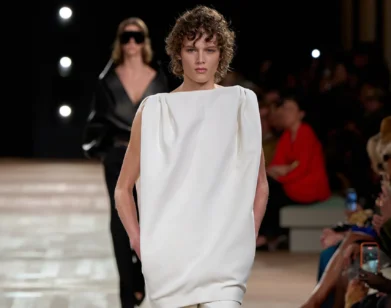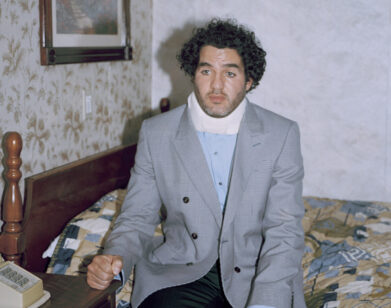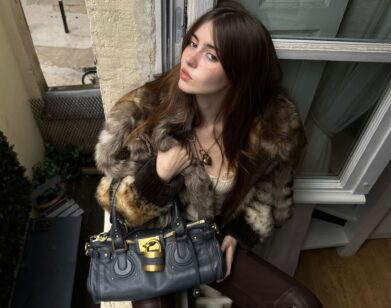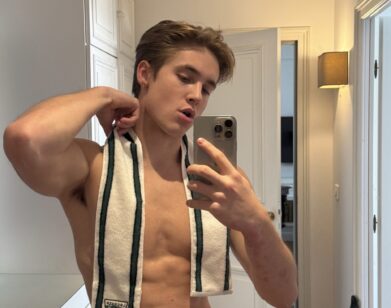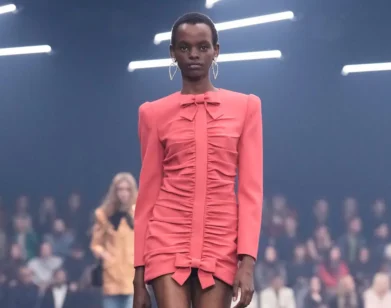At the Heart of Jaquelyn Jablonski
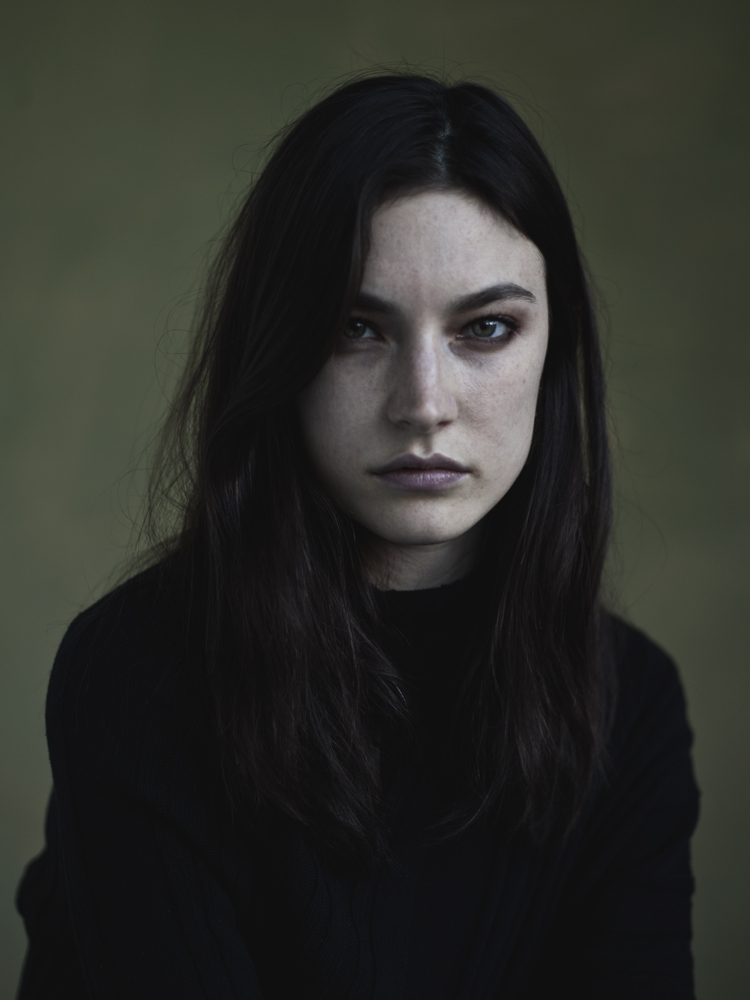
ABOVE: JACQUELYN JABLONSKI IN NEW YORK, APRIL 2014. PHOTO BY VAN SARKI
Model Jacquelyn Jablonski doesn’t seem like she has much to worry about: she’s walked in hundreds of shows since 2007, when she was discovered at 15. She’s been the face of Tommy Hilfiger and starred in a Calvin Klein campaign. Her legs are still immaculately toned from high school soccer. When she’s not en route to some glowing fashion capital, she likes grabbing dinner with her family or with friends like Hanne Gaby Odiele, Julia Nobis, and Alana Zimmer.
But back home in New Jersey, for her little brother Tommy and her parents, every day is a struggle. Tommy was diagnosed with autism at age two. On the severe side of the spectrum, his condition isn’t an easy one. Autism can often lead to hypersensitivity to sounds and activity; anything from loud or unexpected music to mall crowds could be overwhelming. Distressed, a child might run away from his or her caretakers—hugely dangerous for someone who isn’t able to clearly communicate—or fall into a seemingly inconsolable fit. It’s a different situation for every family, and there isn’t yet a simple or single answer for how to help and address treating autism. Even though reports on the mental condition have risen in recent years, funding for research and awareness remains absolutely essential.
Jablonski felt like she had to pitch in. Her work with the Autism Speaks foundation was sparked by a conference she and her mother visited. “It was amazing because you saw so many people in the room with similar stories, and it was just so interesting to hear all these stories,” she remembers. “You really felt not alone. And it made me want to do more with this charity.”
The chance came when, in April 2013, she rang the New York Stock Exchange bell with Tommy to kick off Autism Awareness Month. Autism Speaks members were present. She started talking with them about hosting an event; it came together in June in the form of a silent auction at the Gabarron Foundation Carriage House Center for the Art, where Odiele and model Sara Blomqvist reportedly fell into a deadlocked bidding war.
Tonight, Jablonski hopes to do it all again. The event will be at the gallery at Milk, an epicenter of culture and creative industries in New York. Famous photographers from Peter Lindbergh to Sebastian Kim to Craig McDean donated works for the auction.
When we spoke with her earlier this week, Jablonski was polishing her keynote speech.
RACHEL SMALL: Can you tell us a bit more about how you became involved with Autism Speaks?
JACQUELYN JABLONSKI: My brother was diagnosed with autism, so it’s something that hits close to home. And as I got older—especially when I started modeling and being in the city—I wanted to do help. When I got older and spoke with my parents about it, we were always checking the Autism Speaks website.
I was already talking to my agency about wanting to do a [charity] event. But it’s like, how do you just go about it? I don’t know that. I’ve never planned an event, I had no idea where to begin. When I [met people from Autism Speaks], they gave me the push I needed to make it happen. They explained that they’re behind me. They were all, “Let’s make it happen. Let’s do it.” After last year’s event, I immediately started planning the event at Milk.
SMALL: I feel like Milk makes it more mainstream.
JABLONSKI: It’s going to be in the gallery space. This year, we decided to make the prints the focus—because I noticed last year everyone was staring at the walls and the prints. Designer stuff is amazing, but it’s also tough. Dress sizes—you can’t try it on. We all thought maybe, since they do so many shows there, why not do all prints? Now we have about 40 to 50 prints being donated, which is amazing. It’s been from personal work, to fashion, all kinds. So it’s a good mix.
SMALL: How did you get reach out to the photographers?
JABLONSKI: Craig McDean was probably one of the first people I shot with. I shot with him for years with Tommy Hilfiger and a few other jobs. He’s just so nice and just a super normal, funny guy. So I was really happy to hear he was donating. Patrick Demarchelier was one of my first donations last year. I was shocked. That was kind of what I needed to help me. And it was a huge, huge print, leaning on the floor because it was so big. Of an elephant. [His team] was like “Whatever is going to raise the most money for your charity.” I was really thankful to have been so supported. This year it’s a giraffe.
SMALL: So there’s a theme.
JABLONSKI: [laughs] Yes.
SMALL: My little brother is actually autistic too—I’m familiar with the relationship.
JABLONSKI: Wow. So, where is he on the spectrum? I’m always curious to hear different stories.
SMALL: He’s functional but he still needs a lot of supervision, like with reading and writing.
JABLONSKI: Same with my brother. There were different moments growing up where he would run away. Or everyday activities, from brushing your teeth to making friends, is difficult to him. We had to teach him for a month just to brush his teeth. The things that come easy to us, that we take for granted, do not for him.
SMALL: What’s your relationship with your with your brother like? I tell my brother about art I see, sometimes, because he’s interested in that.
JABLONSKI: My brother is pretty severe, so I’m not sure if he 100 percent understands, but it’s funny, because sometimes when I come home from trips, I have my suitcase. If I haven’t seen my family in awhile, I’ll go home and I’ll have my suitcase. And I’ve done that a few times, and every time I come home my brother immediately associates my suitcase with the whole family is going on a vacation to Florida, because we go once a year to Florida. And he’s like, “Airplane, Florida, airport, now,” just nonstop, so he associates me and the suitcase with that we’re going to Florida, and my mom’s like, “No, just Jacquelyn is going to the airport,” and he goes, “I want to go, I want to go.”
SMALL: Is he going to be there on Thursday?
JABLONSKI: Yes, he’s going to be there. He was there last year, and he had fun. They had an upstairs—no one really went upstairs—but that’s where the kitchen was. But my brother escaped for a bit, because one of his obsessions is chicken fingers. So that was one of the hors d’oeuvres being served, and he kind of found out where the kitchen was and chose to hang out there for a bit.
SMALL: What are your greatest hopes for this evening?
JABLONSKI: I mean, at the end of the day, I want to, of course, raise as much money as I can. The CDC announced last week that the numbers are now higher. So I want to express how important it is to raise awareness, and show that even for people that aren’t even looking to have kids, they should be aware that this is a big deal and needs our attention.
SMALL: Yeah. I noticed you posted the report on your Instagram. What’s the use of social media for you?
JABLONSKI: It’s always nice when someone reaches out and says, “I have a brother,” or “I have someone else.” Some people are really sweet and they’re like, “Aw, you’re my role model, thank you for doing this.” This is why I do it. I want to use being involved in this industry and [take advantage of] my contacts in order to raise awareness. It’s something I’ve been wanting to do for so long.
SMALL: So this is to raise awareness. What sort of strategies will this money sort of go to?
JABLONSKI: I’m actually working on with Autism Speaks right now. Last year it went to autism research. Since my brother’s 18, I wanted to work on a program for these older kids. A lot of the schools’ [special education programs] end when the kids are 21, like my brother’s school. What is next for these kids? I want him to be constantly active, and not just sitting at home. I want him to be constantly growing and it would be amazing if the funds could go to something like jobs for these kids, or a home where they can be together. But, again, these homes and these things need to raise a lot of money because they need around the clock watching. I’m looking into different parts of Autism Speaks. There’s a program that, I think, suits that. There’s a lot of focus on the first, early diagnosis of younger kids, which is amazing, but I’m wondering, what about these older kids? What happens with them? So I would like to try to find something that fits that.
SMALL: Yeah, there’s a lot of emphasis placed on early education, but it’s not always… It can be not nearly enough. How do you extend that and create something sustainable? So what are the last things you’re taking care of for the event?
JABLONSKI: Well, I’ve been starting to scribble on paper about my speech, but then I get distracted, so I know I’m going to be doing that the night before. Last year I wrote a speech and I never even said any of it. It stayed in my purse that I didn’t even carry on me that night… it was in a coat check. So I hope I actually say some of the things I actually want to say this year. But it’s all scribble, it doesn’t even make sense.
I want to try to say that more [this year], because last year I said nowhere near as much as I want to. It’s right before the auction ends, so I kind of want to give the final, “Hey, go put another bid in.” [laughs] “This is serious!” Maybe I’ll throw a joke in there, but I need to be more serious.
SMALL: Keep it light, catch them off guard, and be like, “So, I’m laughing… but seriously, guys.”
JABLONSKI: “Go bid, it’s ending now. I will outbid you if you don’t. Or else.”
SMALL: I can’t wait to see all the prints. And the giraffe.
JABLONSKI: I think I’m going to bid on that.
JACQUELYN JABLONSKI IS REPRESENTED BY SUPREME MANAGEMENT. AUTISM SPEAKS, A NIGHT FOR AUTISM, IS TAKING PLACE TONIGHT, APRIL 3, AT MILK GALLERY ON WEST 15TH STREET IN NEW YORK. FOR MORE INFORMATION, OR TO DONATE TO AUTISM SPEAKS, VISIT THE FOUNDATION’S WEBSITE.

